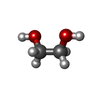[English] 日本語
 Yorodumi
Yorodumi- PDB-9nhf: The structure of a family 168 glycoside hydrolase from the marine... -
+ Open data
Open data
- Basic information
Basic information
| Entry | Database: PDB / ID: 9nhf | ||||||
|---|---|---|---|---|---|---|---|
| Title | The structure of a family 168 glycoside hydrolase from the marine bacterium Muricauda eckloniae. | ||||||
 Components Components | Glycosyl hydrolase-like family 15 (GHL15) protein | ||||||
 Keywords Keywords | HYDROLASE / Glycoside Hydrolase / GH168 / fucoidan / Muricauda / fucoidanase | ||||||
| Function / homology | Hypothetical glycosyl hydrolase family 15 / Hypothetical glycosyl hydrolase family 15 / Glycoside hydrolase superfamily / Glycosyl hydrolase-like family 15 (GHL15) protein Function and homology information Function and homology information | ||||||
| Biological species |  Flagellimonas eckloniae (bacteria) Flagellimonas eckloniae (bacteria) | ||||||
| Method |  X-RAY DIFFRACTION / X-RAY DIFFRACTION /  SYNCHROTRON / SYNCHROTRON /  MOLECULAR REPLACEMENT / Resolution: 2 Å MOLECULAR REPLACEMENT / Resolution: 2 Å | ||||||
 Authors Authors | Knudson-Goerner, E.J. / Boraston, A.B. | ||||||
| Funding support |  Canada, 1items Canada, 1items
| ||||||
 Citation Citation |  Journal: Acta Crystallogr.,Sect.F / Year: 2025 Journal: Acta Crystallogr.,Sect.F / Year: 2025Title: The structure of a family 168 glycoside hydrolase from the marine bacterium Muricauda eckloniae. Authors: Knudson-Goerner, E. / Boraston, A.B. | ||||||
| History |
|
- Structure visualization
Structure visualization
| Structure viewer | Molecule:  Molmil Molmil Jmol/JSmol Jmol/JSmol |
|---|
- Downloads & links
Downloads & links
- Download
Download
| PDBx/mmCIF format |  9nhf.cif.gz 9nhf.cif.gz | 219.2 KB | Display |  PDBx/mmCIF format PDBx/mmCIF format |
|---|---|---|---|---|
| PDB format |  pdb9nhf.ent.gz pdb9nhf.ent.gz | 138.9 KB | Display |  PDB format PDB format |
| PDBx/mmJSON format |  9nhf.json.gz 9nhf.json.gz | Tree view |  PDBx/mmJSON format PDBx/mmJSON format | |
| Others |  Other downloads Other downloads |
-Validation report
| Summary document |  9nhf_validation.pdf.gz 9nhf_validation.pdf.gz | 440.7 KB | Display |  wwPDB validaton report wwPDB validaton report |
|---|---|---|---|---|
| Full document |  9nhf_full_validation.pdf.gz 9nhf_full_validation.pdf.gz | 445.4 KB | Display | |
| Data in XML |  9nhf_validation.xml.gz 9nhf_validation.xml.gz | 41.5 KB | Display | |
| Data in CIF |  9nhf_validation.cif.gz 9nhf_validation.cif.gz | 59.1 KB | Display | |
| Arichive directory |  https://data.pdbj.org/pub/pdb/validation_reports/nh/9nhf https://data.pdbj.org/pub/pdb/validation_reports/nh/9nhf ftp://data.pdbj.org/pub/pdb/validation_reports/nh/9nhf ftp://data.pdbj.org/pub/pdb/validation_reports/nh/9nhf | HTTPS FTP |
-Related structure data
| Similar structure data | Similarity search - Function & homology  F&H Search F&H Search |
|---|
- Links
Links
- Assembly
Assembly
| Deposited unit | 
| ||||||||||||
|---|---|---|---|---|---|---|---|---|---|---|---|---|---|
| 1 | 
| ||||||||||||
| 2 | 
| ||||||||||||
| Unit cell |
|
- Components
Components
| #1: Protein | Mass: 44194.117 Da / Num. of mol.: 2 Source method: isolated from a genetically manipulated source Source: (gene. exp.)  Flagellimonas eckloniae (bacteria) / Strain: DOKDO 007T / Gene: AAY42_01205 / Production host: Flagellimonas eckloniae (bacteria) / Strain: DOKDO 007T / Gene: AAY42_01205 / Production host:  #2: Chemical | ChemComp-EDO / | #3: Water | ChemComp-HOH / | Has ligand of interest | N | Has protein modification | N | |
|---|
-Experimental details
-Experiment
| Experiment | Method:  X-RAY DIFFRACTION / Number of used crystals: 1 X-RAY DIFFRACTION / Number of used crystals: 1 |
|---|
- Sample preparation
Sample preparation
| Crystal | Density Matthews: 2.65 Å3/Da / Density % sol: 53.67 % / Description: rod |
|---|---|
| Crystal grow | Temperature: 291.15 K / Method: vapor diffusion, sitting drop / pH: 7 / Details: 20% w/v PEG 3350, 8% v/v Tacsimate pH 7.0 |
-Data collection
| Diffraction | Mean temperature: 100 K / Serial crystal experiment: N |
|---|---|
| Diffraction source | Source:  SYNCHROTRON / Site: SYNCHROTRON / Site:  CLSI CLSI  / Beamline: 08ID-1 / Wavelength: 0.954 Å / Beamline: 08ID-1 / Wavelength: 0.954 Å |
| Detector | Type: DECTRIS EIGER X 9M / Detector: PIXEL / Date: Aug 15, 2023 |
| Radiation | Protocol: SINGLE WAVELENGTH / Monochromatic (M) / Laue (L): M / Scattering type: x-ray |
| Radiation wavelength | Wavelength: 0.954 Å / Relative weight: 1 |
| Reflection | Resolution: 2→97.31 Å / Num. obs: 64544 / % possible obs: 100 % / Redundancy: 7.6 % / Biso Wilson estimate: 23.59 Å2 / CC1/2: 0.997 / Rmerge(I) obs: 0.132 / Rpim(I) all: 0.051 / Rrim(I) all: 0.142 / Net I/σ(I): 12.8 |
| Reflection shell | Resolution: 2→2.05 Å / Redundancy: 8 % / Rmerge(I) obs: 0.978 / Mean I/σ(I) obs: 2.4 / Num. unique obs: 4512 / CC1/2: 0.764 / Rpim(I) all: 0.364 / % possible all: 100 |
- Processing
Processing
| Software |
| ||||||||||||||||||||||||||||||||||||||||||||||||||||||||||||||||||||||||||||||||||||||||||||||||||||||||||||||||||||||||||||||||||||||||||||||||||||||||||||||||||||||||
|---|---|---|---|---|---|---|---|---|---|---|---|---|---|---|---|---|---|---|---|---|---|---|---|---|---|---|---|---|---|---|---|---|---|---|---|---|---|---|---|---|---|---|---|---|---|---|---|---|---|---|---|---|---|---|---|---|---|---|---|---|---|---|---|---|---|---|---|---|---|---|---|---|---|---|---|---|---|---|---|---|---|---|---|---|---|---|---|---|---|---|---|---|---|---|---|---|---|---|---|---|---|---|---|---|---|---|---|---|---|---|---|---|---|---|---|---|---|---|---|---|---|---|---|---|---|---|---|---|---|---|---|---|---|---|---|---|---|---|---|---|---|---|---|---|---|---|---|---|---|---|---|---|---|---|---|---|---|---|---|---|---|---|---|---|---|---|---|---|---|
| Refinement | Method to determine structure:  MOLECULAR REPLACEMENT / Resolution: 2→48.65 Å / SU ML: 0.2234 / Cross valid method: FREE R-VALUE / σ(F): 1.34 / Phase error: 23.7983 MOLECULAR REPLACEMENT / Resolution: 2→48.65 Å / SU ML: 0.2234 / Cross valid method: FREE R-VALUE / σ(F): 1.34 / Phase error: 23.7983 Stereochemistry target values: GeoStd + Monomer Library + CDL v1.2
| ||||||||||||||||||||||||||||||||||||||||||||||||||||||||||||||||||||||||||||||||||||||||||||||||||||||||||||||||||||||||||||||||||||||||||||||||||||||||||||||||||||||||
| Solvent computation | Shrinkage radii: 0.9 Å / VDW probe radii: 1.11 Å / Solvent model: FLAT BULK SOLVENT MODEL | ||||||||||||||||||||||||||||||||||||||||||||||||||||||||||||||||||||||||||||||||||||||||||||||||||||||||||||||||||||||||||||||||||||||||||||||||||||||||||||||||||||||||
| Displacement parameters | Biso mean: 27.73 Å2 | ||||||||||||||||||||||||||||||||||||||||||||||||||||||||||||||||||||||||||||||||||||||||||||||||||||||||||||||||||||||||||||||||||||||||||||||||||||||||||||||||||||||||
| Refinement step | Cycle: LAST / Resolution: 2→48.65 Å
| ||||||||||||||||||||||||||||||||||||||||||||||||||||||||||||||||||||||||||||||||||||||||||||||||||||||||||||||||||||||||||||||||||||||||||||||||||||||||||||||||||||||||
| Refine LS restraints |
| ||||||||||||||||||||||||||||||||||||||||||||||||||||||||||||||||||||||||||||||||||||||||||||||||||||||||||||||||||||||||||||||||||||||||||||||||||||||||||||||||||||||||
| LS refinement shell |
|
 Movie
Movie Controller
Controller


 PDBj
PDBj


